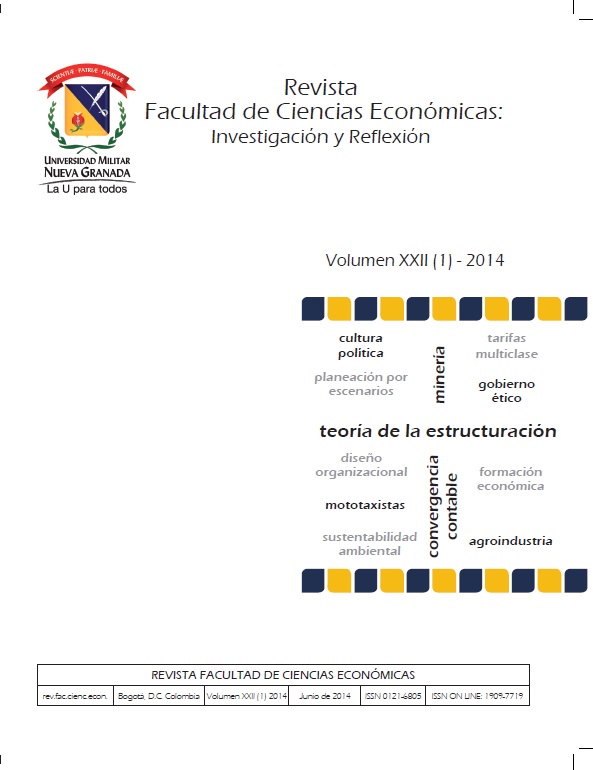Second level price differentiation: case of multiclass price for trademark registry in Colombia
Abstract
This paper shows the implementation of a second level price differentiation of industrial property price, in particular the multi-class system, this is because Colombia’s accession to Madrid’s Protocol in 2011. The methodology is based on a model to establish an optimal trademark price structure with two objectives: (i) to accomplish commitments under the TLT and encourage the use of multi-class system, and (ii) to identify a mechanism to reduce negative effects, which in terms of collection could face industrial property authority, based on the agreement in force. Among main findings, the inverse unequivocal existence between price and number of requests was identified, considering multiple factors that can affect the demand trademark service. Additionally, it was established that this differentiated price system leveraged the decrease on revenues from the industrial property management authority in Colombia given the observed demand service characteristics.
Downloads
References
Bonnet, C. & Dubois, P. (2010). “Inference on vertical contracts between manufacturers and retailers allowing for nonlinear pricing and resale price maintenance”. En: The RAND Journal of Economics, 41(1): 139–164.
Braverman, A., Guasch, J. & Salop, S. (1983). “Defects in Disneyland: Quality Control as a Two-Part Tariff”. En: The Review of Economic Studies, 50(1): 121-131.
Chang, R-Y., Hwang, H. & Peng, C-H. (2013). “Technology licensing, R&D and welfare”. En: Economics Letters, 118 (2): 396-399.
Chen, J., Zhang, H. & Sun, Y. (2012). “Implementing coordination contracts in a manufacturer Stackelberg dual-channel supply chain”. En: Omega, 40(5): 571-583.
Corcione, M. (2010). “El TLT (Trade Law Treaty) y los retos para la Superintendencia de Industria y Comercio como oficina de propiedad industrial”. En: Revista La Propiedad Material, 14: 319-326.
Cornia, M., Gerardi, K. & Shapiro, A. (2011). Price Discrimination and Business-Cycle Risk (Working Paper 2011-3). Atlanta, Federal Reserve Bank Of Atlanta.
Felder, S. (2004). “Drug price regulation under consumer moral hazard Two-part tariffs, uniform price or third-degree price discrimination?”. En: The European Journal of Health Economics, 5(4): 324-329.
Ferreira, F. & Bode, O. R. (2013). “Licensing endogenous cost-reduction in a differentiated Stackelberg model”. En: Communications in Nonlinear Science and Numerical Simulation, 18(2): 308-315.
Gotlibovski, C. & Kahana, N. (2009). “Second-Degree Price Discrimination: A Graphical and Mathematical Approach”. En: Journal of Economic Education, 40(1): 68-79.
Inderst, R. & Shaffer, G. (2009). “Market power, price discrimination, and allocative efficiency in intermediate-goods markets”. En: The RAND Journal of Economics, 40(4): 658-672.
Kim, S.L., Park, C.H. & Lee, S.H. (2012). “Environmental Tax and Licensing a Patent for Clean Technology Management”. En: Procedia - Social and Behavioral Sciences, 57(9): 95-101.
Lambertini, L. (2013). “Coordinating static and dynamic supply chains with advertising through two-part tariffs”. Automatica, Doi: http://dx.doi.org/10.1016/j.automatica.2013.11.024
Li, Y. & Yanagawa, T. (2011). “Patent licensing of Stackelberg manufacturer in a differentiated product market”. En: International Journal of Economic Theory, 7(1): 7-20.
Ma, P, Wang, H. & Shang, J. (2013). “Contract design for two-stage supply chain coordination: Integrating manufacturer-quality and retailer-marketing efforts”. En: International Journal of Production Economics, 146 (2): 745-755.
Mendonca, S., Pereira, T. & Godinho, M. (2004). Trademarks as an Indicator of Innovation and Industrial Change. En: Research Policy, 33: 1385-1404.
Matsui, K. (2012). “Strategic upfront marketing channel integration as an entry barrier”. En: European Journal of Operational Research, 220 (3): 865-875.
Mukherjee, A. & Mukherjee, S. (2013). “Technology licensing and innovation”. En: Economics Letters, 120 (3): 499-502.
Nicholson, W. (2012). Microeconomic Theory: Basic Principles and Extensions. Ed South Western. Cengage Learning.
Oliveira, F., Ruiz, C. & Conejo, A. (2013). “Contract design and supply chain coordination in the electricity industry”. En: European Journal of Operational Research, 227 (3): 527-537.
OMPI (1994). Tratado sobre Derecho de Marcas. Disponible en: http://www.wipo.int/treaties/es/ip/tlt/trtdocs_wo027.html
OMPI (2012). Individual Fees under the Madrid Protocol. Disponible en: http://www.wipo.int/madrid/en/madridgazette/remarks/ind_taxes.html
OMPI (2014). List of Goods and Services by Class Order. Disponible en: http://web2.wipo.int/nicepub/edition-20140101/taxonomy/#?pagination=no&lang=en&mode=flat&explanatory_notes=hide&basic_numbers=show&_suid=13896300847410142359155526394
Rosellon, J., Tregear, J. & Zenon, E. (2012). El modelo HRV para expansión óptima de redes de transmisión: una aplicación a la red eléctrica de Ontario. En: Economía Mexicana, Nueva Época, 21(1): 133-173.
Ruiz, E. & Rosellón, J. (2012). “Transmission investment in the Peruvian electricity market: Theory and applications”. En: Energy Policy, 47: 238-245.
Steele Santos, P., Coradi Leme, R. & Galvão, L. (2012). “On the electrical two-part tariff—The Brazilian perspective”. En: Energy Policy, 40: 123-130.
Superintendencia de Industria y Comercio (2012). Presupuesto de la Superintendencia de Industria y Comercio ante el Ministerio de Hacienda y Crédito Público. Disponible en http://www.sic.gov.co/recursos_user/documentos/Conozcanos/Gestion/Presupuesto/Formularios_Anteproyecto_2012.pdf
Superintendencia de Industria y Comercio SIC (2011). Resolución número 75.858 de 2011 “Solicitud de registro de marcas de productos o servicios, de marcas colectivas, de marcas de certificación y de lemas comerciales”. Bogotá: Superintendencia de Industria y Comercio.
Superintendencia de Industria y Comercio – SIC (2008). Marcas. Guía de propiedad industrial. Bogotá: SIC. Disponible en: http://www.sic.gov.co/recursos_user/documentos/propiedad_industrial/WEB/assets/pdf/Guia_Marcas.pdf
Vargas, C. (2012). Estudio Tasas en Propiedad Industrial. Bogotá: Superintendencia de Industria y Comercio.
Wang, X. H. (2002). “Fee versus royalty licensing in a differentiated Cournot duopoly”. En: Journal of Economics and Business, 54: 253–66.
Watika, S. (2001). “Why has the Unemployment Rate Been so Low in Japan? An Explanation by Two-Part Wage Bargaining”. En: Japanese Economic Review, 52: 116-133.
Willington, M. & Li Ning, J. (2014). “Regulating a monopoly with universal service obligations: The role of flexible tariffschemes. En: Telecommunications Policy, 38(1): 32-48.
Yao, S. (2002). “Privilege and Corruption The Problems of China’s Socialist Market Economy”. En: American Journal of Economics and Sociology, 61(1): 279–299.











